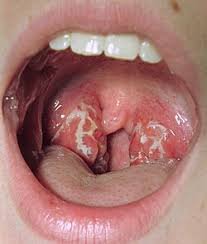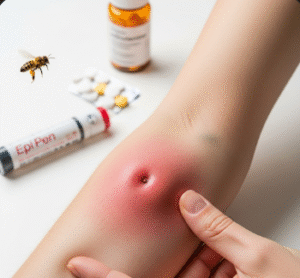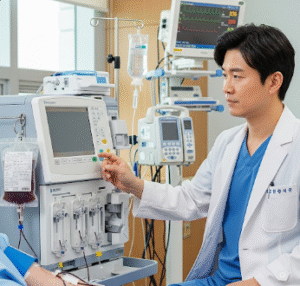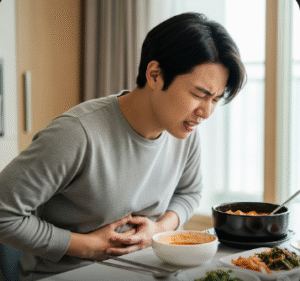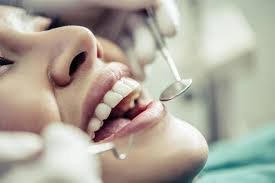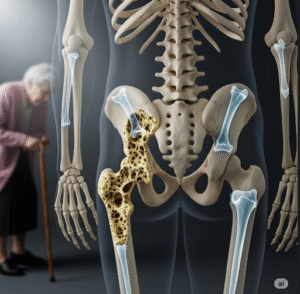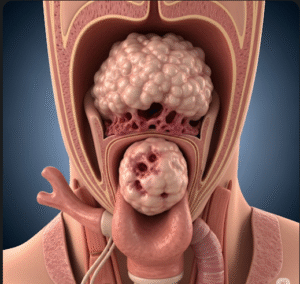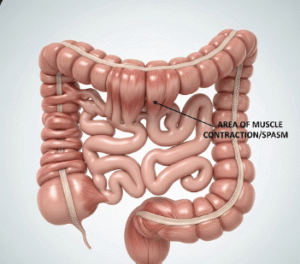Overview
Strep throat is a bacterial throat infection that causes inflammation and pain in the throat. It is most common in children and teens but can affect people of all ages. In Korea, strep throat cases increase during colder months and school seasons, where close contact among individuals facilitates transmission. Korean clinics and hospitals offer rapid testing and treatment to prevent complications and limit the spread of infection.
What is Strep Throat?
Strep throat is an infection of the throat and tonsils caused by Group A Streptococcus (GAS) bacteria. It is a type of acute bacterial pharyngitis that develops quickly and spreads easily through respiratory droplets.
Unlike viral sore throats, strep throat requires antibiotic treatment. It presents with sudden onset sore throat, fever, and white patches on the tonsils. If untreated, it can lead to complications such as rheumatic fever or kidney inflammation.
Symptoms
Common symptoms of strep throat include:
- Sudden, severe sore throat
- Painful swallowing
- Red, swollen tonsils (often with white patches or pus)
- Fever (typically >38.5°C or 101.3°F)
- Swollen lymph nodes in the neck
- Headache
- Nausea or vomiting (especially in children)
- Rash (scarlet fever in some cases)
Strep throat does not usually cause cough or runny nose—these symptoms suggest a viral infection instead.
Causes
Strep throat is caused by Group A Streptococcus (GAS) bacteria. The infection is transmitted via:
- Inhalation of airborne droplets from coughing or sneezing
- Sharing utensils, drinks, or towels with an infected person
- Touching contaminated surfaces and then touching the mouth or nose
Outbreaks are more common in crowded settings like schools, daycare centers, and military training camps in Korea.
Risk Factors
Risk factors for strep throat include:
- Age (children between 5–15 years are most at risk)
- Close contact with infected individuals
- Seasonal peaks (late fall through early spring)
- Weakened immune system
- Living or working in group settings (schools, dormitories, military)
Complications
If strep throat is not treated, it can lead to serious complications, such as:
- Rheumatic fever (affects heart valves and joints)
- Post-streptococcal glomerulonephritis (kidney inflammation)
- Peritonsillar abscess (pus behind the tonsils)
- Sinusitis or ear infections
- Scarlet fever
Prompt diagnosis and antibiotic treatment in Korea help prevent most of these outcomes.
Prevention
To reduce the risk of strep throat:
- Practice regular handwashing
- Avoid close contact with people who have sore throats or fevers
- Cover mouth and nose when coughing or sneezing
- Do not share food, drinks, or personal items
- Seek early treatment for symptoms
- Keep children home from school for at least 24 hours after starting antibiotics
Treatment Options in Korea
Korea’s medical system is well-equipped to diagnose and treat strep throat rapidly, minimizing downtime and preventing complications.
Diagnosis
- Rapid Antigen Detection Test (RADT): Widely available at clinics for same-day results
- Throat Swab Culture: Used to confirm RADT results or in severe/recurrent cases
- Blood tests (rare): May be used for suspected complications like rheumatic fever
Medical Treatments
- Antibiotics: First-line treatments include penicillin or amoxicillin; alternatives like cephalexin or azithromycin are used for allergies
- Fever and pain control: Acetaminophen or ibuprofen
- Hydration and rest: Emphasized during treatment
- Saltwater gargles or throat lozenges: For symptom relief
Most clinics in Korea prescribe a 10-day antibiotic course, but symptoms typically improve within 48–72 hours of starting treatment.
Surgical or Advanced Therapies
- Tonsillectomy: Recommended for patients with frequent recurrent strep infections or complications such as abscesses. Performed in tertiary hospitals like Asan Medical Center or Seoul National University Hospital.
Rehabilitation and Support
- Follow-up visits: To ensure the infection has cleared, especially in children
- Health education: Provided in schools and public clinics to prevent reinfection
- Public health monitoring: Managed by the Korea Disease Control and Prevention Agency (KDCA) during outbreaks

